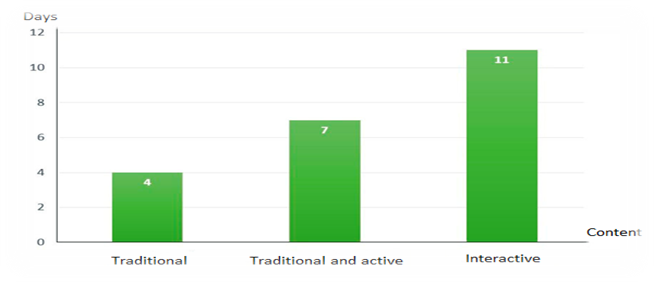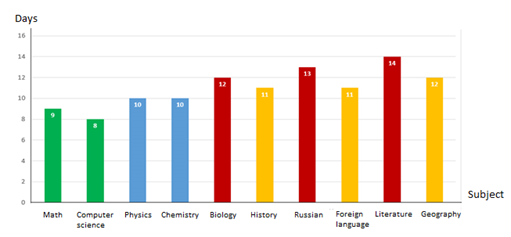Abstract
A modern educational process requires system development and modernization of information resources. A special attention is paid to the designing of electronic educational content that will help to organize the basic and additional educational process in educational institutions. Designing of the electronic educational content requires: for teachers of educational institutions to be ready to design the content and apply it in the educational process; the content should meet the didactic, physiological, health standards; the content should be introduced to the learning environment of an educational institution and provide all the participants of the educational process with direct access to it; the content should improve the quality of the educational process through the active use of interactive exercises; intermediate knowledge assessment and prompt access to educational and library resources. Development of interactive educational content in contrast to traditional and traditional and active content requires extra knowledge and communicative skills. However, as practice shows such competence is poorly developed with almost every teacher of educational institutions with the exception of computer science and math teachers. That is why teachers of educational institutions should take a refresher course on design and development of electronic educational content. This course will help them to acquire special competence in content designing and teach them how to apply the content in the educational process. Teachers will also create the electronic educational content on the subject they teach. This course will help to create a high-quality interactive educational content and will improve teacher’s knowledge and communicative skills.
Keywords: E-educationeducational institutioncontentinteractive content
Introduction
One of the main pedagogical priorities is to introduce an e-education in the school system. Today the program on development of e-education is being implemented on the federal level. Vladimir Putin, the President of the Russian Federation, in his speech at the State Council meeting on improving the system of general education noted that with a high-quality Internet access distance education and widespread use of electronic educational resources become more effective, though we still do not have enough high-quality electronic educational resources. The problem is also being dealt with at the regional level. In particular, the program on Promotion of E-education in Educational Institutions of the Republic of Bashkortostan under the Government Decree of the Republic of Bashkortostan No. 368 dated September 10, 2015, On Approval of the Electronic Education Development Concept in the Republic of Bashkortostan for the period of 2015-2020 (Postanovlenie…, 2015) is being implemented.
Problem Statement
Today the development of innovative, high-quality and effective electronic educational resources is one of the main tasks of e-education promotion. The e-resources progress has made it possible to replace text, analogue, video and audio resources with interactive and multimedia electronic educational resources. There is a significant change in the standard of the electronic educational resources and their application in the educational process. Information and learning resources become an essential part of educational environment (Zaitseva, 2016).
In the process of creating the information and learning resources database a special attention is paid to the design and development of electronic educational content. For now though, there is no unified standard for content design.
Teachers can either design the content themselves or use the electronic content freely available on the Internet. And while the process of creating electronic educational products does not cause a problem for a computer science teacher, teachers in other subjects with no IT-qualifications may experience a certain difficulty. The significant problem is that in both cases the content used in teaching practice does not always meet didactic, technological, psychological requirements, sanitary and epidemiological standards.
The comprehensive analysis of the educational, personnel, material and technical resources of educational institutions allow us to conclude that the designing of electronic educational content and its application in the educational environment faces the following problems: insufficient technical and technological base, lack of high-quality software and licensed programs, lack of teacher’s competence in designing the electronic educational products and using the distance learning technologies.
The solution to this problem is to formulate the requirements for the designing of electronic educational content and its application in the electronic educational process. When creating electronic educational content, one should take the following general requirements into account:
general didactic principles of the teaching material design;
psycho-physiological aspect of information perception;
ergonomic requirements for the information presentation;
sanitation and hygiene.
Research Questions
It is necessary to take into account the specific requirements for the design and application of educational content in e-learning process and distance learning technologies. This product should include a lot of interactive elements. Thus, electronic educational content can be subdivided into several types according to the amount of content information, the degree of its interactivity, the degree of student involvement. The simplest type of interactive content is a
Next type of electronic educational content is
The designing of the above types of content (traditional, traditional and active, interactive) requires teacher’s special training. The most effective way to solve this problem is to complete a refresher course for school teachers. For this purpose, Teacher Electronic Educational Content Designing refresher course was created and tested within the E-education Development Program of the Republic of Bashkortostan. 105 teachers from 23 general educational institutions have successfully completed this course. The analysis of the refresher course conclusions (figure

The designing of electronic educational content takes a certain amount of time, depending on the level of teacher’s knowledge and communicative skills. The study has shown that it takes the least amount of time with computer science and math teachers. And conversely, it takes the most amount of time with Russian language and literature teachers. Thus, we can conclude that content designing takes less time with science teachers, whereas arts teachers spend the most amount of time working on it (Figure

Purpose of the Study
This paper is aimed at designing interactive educational content by teachers of educational institutions.
Research Methods
During the study the following methods were used:
theoretical: analysis of scientific and pedagogical literature, systematic approach;
empirical: monitoring, description, comparison, survey and experiment.
Findings
Upon refresher course completion teachers have acquired competence in designing of interactive electronic educational content for the main and extracurricular educational activities. According to the degree of content interactivity it can be subdivided into (Galikhanov, Sergienko, & Sergienko, 2018):
-Traditional content , which includes:
Conclusion
The developed interactive educational content is being successfully applied in the educational process in general educational institutions. It is used as an addition to the traditional educational program, for an individual work, to organize extracurricular activities of a group activity clubs using e-learning and distance learning technologies.
Designing of the interactive educational content is an integral part of the modern educational process. Teachers need to have special training course to be able to design an electronic content and apply it in the e-education process. Interactive educational content develops and complements the information and educational environment of a general educational institution, increases the effectiveness and quality of the learning process, makes it more flexible and varied, promotes a bimodal learning system.
References
- Badanov, A. G., & Smolina, S. I. (2017). Interaktivnye elektronnye obrazovatelnye resursy [Interactive electronic educational resources]. Ispolzovanie yazykovogo virtualnogo prostranstva v formirovanii yazykovoj kompetentnosti subjektov bilingvalnoj sredy, 34-39.
- Galikhanov, Yu. R., Sergienko, E. B., & Sergienko, I. V. (2018). Konstruirovanie elektronnogo kontenta dlya kruzhkov [Designing electronic content for group activity clubs]. Ufa: BSPU.
- Karpenko, M. P. (2008). Teleobuchenie [Tele-education]. Moscow: Sovremennaya gumanitarnaya akademiya.
- Postanovlenie pravitelstva Respubliki Bashkortostan ot 10 sentyabrya 2015 g. № 368 «Ob utverzhdenii Kontsepcii razvitiya elektronnogo obrazovaniya v Respublike Bashkortostan na period 2015-2020 godov» [Decree of the government of the Republic of Bashkortostan dated September 10, 2015 No. 368 "On approval of the Electronic education development concept in the Republic of Bashkortostan for the period of 2015-2020"]. (2015, September 11). Retrieved from https://education.bashkortostan.ru/documents/active/48398/
- Zaitseva, O. V. (2016). Formirovanie elektronnykh obrazovatelnykh resursov [Electronic educational resources formation]. Obrazovatelnye resursy i tekhnologii, 4, 21-27.
Copyright information

This work is licensed under a Creative Commons Attribution-NonCommercial-NoDerivatives 4.0 International License.
About this article
Publication Date
15 November 2020
Article Doi
eBook ISBN
978-1-80296-092-1
Publisher
European Publisher
Volume
93
Print ISBN (optional)
-
Edition Number
1st Edition
Pages
1-1195
Subjects
Teacher, teacher training, teaching skills, teaching techniques, special education, children with special needs, computer-aided learning (CAL)
Cite this article as:
Sergienko, I., & Gabbasov, R. (2020). Teacher Interactive Educational Content Designing. In I. Murzina (Ed.), Humanistic Practice in Education in a Postmodern Age, vol 93. European Proceedings of Social and Behavioural Sciences (pp. 863-868). European Publisher. https://doi.org/10.15405/epsbs.2020.11.89

